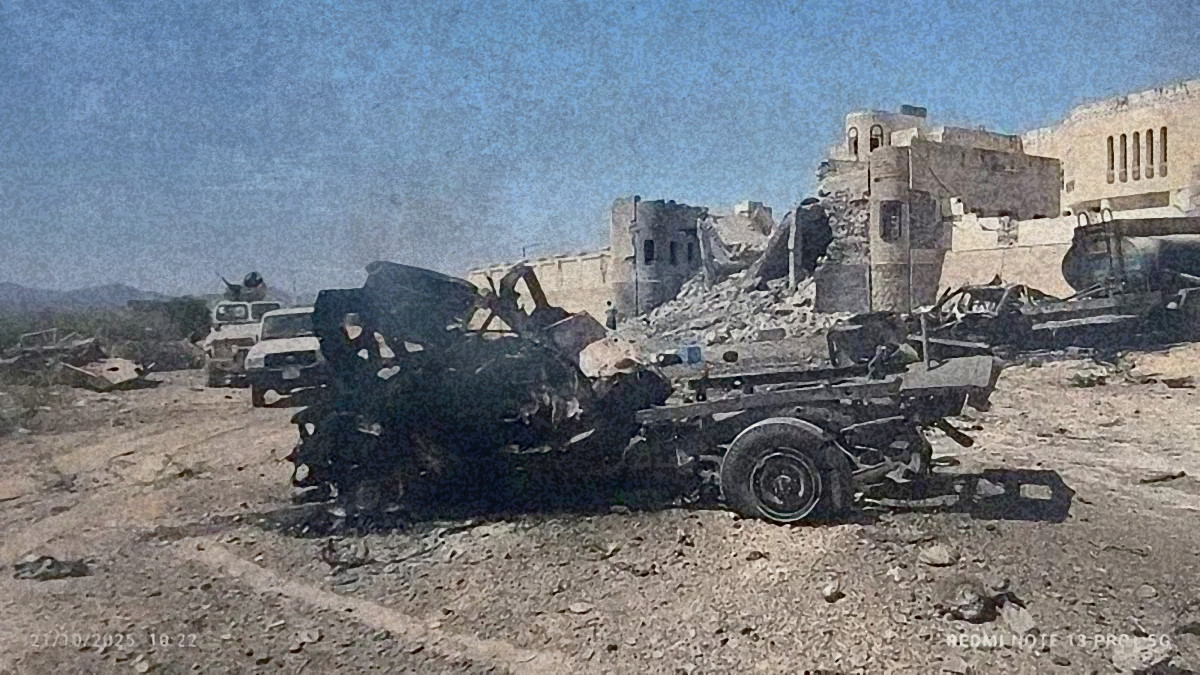Al Mahfad Terrorist Bombing: Significance of Time and Place
- 28 Oct 2025


At 7:30 a.m. on 21 October 2025, al-Qaeda in the Arabian Peninsula (AQAP) carried out an attack targeting the headquarters of the 1st Support and Reinforcement Brigade, one of the Security Belt units affiliated with the Southern Transitional Council (STC).
The attack occurred within the context of a marked escalation that began in mid-2022, during which AQAP operations in Abyan and Shabwa intensified significantly. This surge preceded the STC’s announcement of Operation Arrows of the East—a counter-terrorism campaign aimed at dismantling extremist networks (1). Subsequent months witnessed fluctuating yet sustained militant activity, particularly between May and September 2023, including the assassination of senior security officials (2) and a series of sophisticated bombings in both Al Mahfad and Mudiyah.
In 2024, AQAP experienced a renewed resurgence through a propaganda and mobilisation campaign it called “Tufan Zara.” The term “Tufan” (meaning “deluge”) was deliberately borrowed from Operation al-Aqsa Flood launched by the Palestinian movement Hamas. At the same time, “Zara” refers to an area located west of the city of Lawdar.
The districts of Al Mahfad, Mudiyah, Lawdar, Khanfar, and Ahwar in Yemen’s southern Abyan Governorate are under the control of the Security Belt Forces affiliated with the Southern Transitional Council (STC). Although STC forces maintain control over most parts of the governorate, AQAP continues to operate in remote, hard-to-reach areas across mountain villages and valleys, particularly in the eastern districts of Al Mahfad and Lawdar.
The Awmaran Valley in Mudiyah remains the group’s principal stronghold, alongside the Al Maraqisha Mountain range stretching through the Mujan and Al Naseel valleys near Lawdar. (3)
AQAP has exploited the rugged mountainous terrain to establish small, dispersed encampments across the districts mentioned above, using them as hideouts and sites for the manufacture of improvised explosive devices (IEDs). The group is no longer capable of holding extensive, stable swathes of territory; consequently, field intelligence remains fluid, and AQAP’s deployment patterns shift after each government military operation or defensive engagement.
Why Does AQAP Seek “Symbolic Victories”?
AQAP employed three suicide operatives to breach the effectiveness of the barriers at the compound gate: Abdulrahman Hasan Saleh Akrout (kunya: Samih al-Sanani), Akram Radwan al-Sharaf (kunya: al-Karrar al-Sanani), and Abubakr al-Hadidi (4). They staged a high-impact initial explosive strike designed to turn off the outer layers of protection, thereby preparing the way for an assault on the building by a vehicle-borne improvised explosive device (VBIED) driven by the jihadist known as al-Baraa al-Ibi. The attackers sought to exploit the resultant confusion and the security forces’ temporary, improvised responses; fighters then rushed into the compound in an attempt to seize it, triggering heavy clashes that lasted approximately 90 minutes.
According to initial assessments of the incident, four members of the Southern Transitional Council’s forces were killed, and approximately fifteen others were wounded, as reported in preliminary accounts. (5) Field sources indicated that all the attackers were killed during the operation, with their number estimated at between five and six, depending on the report consulted.
Given the nature of the attack, notably the use of a vehicle-borne IED to force entry and the predominantly (if not exclusively) suicidal composition of the assault team, the operation was unlikely to have been intended to affect a protracted seizure of the government compound. It instead bears the hallmarks of a suicide-tactical strike designed to breach defences and inflict tangible casualties on the deployed forces, without the logistical tail or conventional occupation units required to hold territory. Moreover, there is no indication of reserve elements or support echelons tasked with sustaining the assault force or securing the compound’s perimeter thereafter — a prerequisite for any durable occupation.
In the short term, by inflicting losses on Southern forces, AQAP sought to reassert its operational presence through symbolic victories that command public attention—a currency that can at times outweigh tactical utility—to undermine adversary morale and reassure support networks that investment in the group continues to yield returns.
It is also notable that AQAP is seeking to expand its operational and offensive footprint in Abyan into areas overlapping with Shabwah and, further, into Al Bayda. AQAP is exploiting the province’s complex local dynamics — including entrenched tribal influence, smuggling economies, and competition among local factions — which create grey zones that permit the group to construct a logistical network capable of sustaining intermittent, successive operations: financing, recruitment and the establishment of secure mountain sanctuaries.
Organisational Tactics and Internal Coordination within AQAP in Southern Yemen
On 19 October 2025, AQAP fired an RPG round at a Security Belt Forces post at the entrance to the al-Wadia district in Abyan (6), an action intended to divert surveillance from a larger operation the group planned two days later in Al Mahfad. The attack was directed by Saad al-Awlaqi, AQAP’s emir for the Arabian Peninsula, and both the mobilisation and execution were carried out by his military committee.
The group’s various factions concurred on the timing for distinct strategic reasons. The Sanaa Bloc judged it opportune given the freezing of other fronts and the expectation of parallel Houthi activity — following the pause in the Gaza conflict — in areas controlled by Yemen’s internationally recognised authorities and, specifically, the south. The Hadrami Bloc, by contrast, viewed the operation as a means to restore the organisation’s prestige and to strengthen its negotiating position vis-à-vis local and external actors. (7)
Field assessments indicate that al-Mahfad may not mark the end of this targeting wave. AQAP’s leadership could employ concurrent operations to ease pressure on its strongholds and compel opponents to redistribute forces. Consequently, surveillance of Shabwah and Al Bayda is imperative: complementary or parallel attacks remain a distinct possibility.
Interpreting Symbolism and Potential Intersections
There is no direct evidence of Houthi involvement in this attack. However, previous indications have suggested instances of tacit coordination or mutual benefit between AQAP and the Houthis in earlier operations. However, the propaganda images released by the group following the assault may serve as a key to deciphering the symbolic messages and strategic signals that AQAP deliberately crafts for both its supporters and the broader regional audience.
The image of the group’s suicide bombers featured, in the background, the phrase “Descendants of Muhammad ibn Maslamah.” Islamic sources recount that Ibn Maslamah was the companion who killed Kaab ibn al-Ashraf, the Jewish poet of Banu al-Nadir. Yet, the same sources also note that he refrained from taking part in what became known historically as the Great Fitna—the first major civil strife between Ali ibn Abi Talib and Muawiya ibn Abi Sufyan—breaking his sword against a rock and replacing it with a wooden one as a symbol of abstention from internal conflict.
The group’s deliberate use of historical and religious symbolism enables it to present itself to other non-state actors as a movement pursuing victory within the bounds of what it frames as “legitimate jihad.” By invoking the notion of abstaining from fitna (internal discord), AQAP signals the autonomy of its decision-making and its calculated restraint from engaging in an all-out sectarian confrontation with its ideological adversary—the Houthis—unless such engagement directly serves its survival and facilitates strategic repositioning without exposing it to multi-front attrition.
In conclusion, AQAP continues to retain a measure of operational presence despite its structural weaknesses, geographic confinement within its traditional strongholds, and the loss of secure territorial havens. Through sporadic attacks—varying in intensity and effectiveness—against government positions, the group seeks to assert itself as an actor capable of generating broad reverberations, rather than merely a besieged defensive force.
In the medium term, AQAP may struggle to balance sustained field operations with the need to avoid attrition among its cadres—particularly through suicide attacks—while facing countervailing pressures from campaigns such as Operation Arrows of the East and US surveillance networks that curtail its manoeuvre space. Consequently, the group is likely to shift operations toward peripheral areas of low security oversight and along strategic corridors and routes—most notably the coastal artery linking Aden to the central-south and the lines connecting Shabwah and Abyan. These routes govern the logistical movement of Southern leadership and forces, provide favourable terrain for staging, concealment, and smuggling, and, if targeted, have the potential to disrupt force projection and supply chains while imposing higher costs in terms of military asset losses.
[1] *تعد عملية اغتيال العميد عبد اللطيف السيد، قائد قوات «الحزام الأمني» بمحافظة أبين، الذي تم استهدافه بعبوة ناسفة استهدفت موكبه في مديرية مودية، هي الابرز للقاعدة ضد القادة الأمنيين.
[2] سهام الشرق» عملية عسكرية في أبين – تفاصيل، مركز ساوث ٢٤ للاخبار والدراسات، ٢٣ أغسطس ٢٠٢٣،
https://south24.net/news/news.php?nid=2882
[3] وادي عومران وتنظيم القاعدة.. الخلفية التاريخية والأهمية الاستراتيجية، درع الجنوب- الموقع الرسمي للقوات المسلحة الجنوبية،
https://deraalganoob.com/posts/37272
[4] الأسماء الحقيقية للمنفذين عملية المحفد -مصدر أمني في القوات التابعة للمجلس الإنتقالي-٢٤ أكتوبر ٢٠٢٥.
[5] ارتفاع حصيلة هجوم "القاعدة" في اليمن إلى 12 قتيلا، اندبيندنت عربي، ٢١ أكتوبر ٢٠٢٥، https://h1.nu/1dnrZ
([6]) هجوم بقذيفة “آر بي جي” يستهدف نقطة للانتقالي في الوضيع وإصابة أحد الجنود، الجنوب اليمني، ١٩ أكتوبر ٢٠٢٥، https://southern-yemen.net/55329
موقع الجنوب اليمني 2025/10/19
([7] مصدر خاص، ٢١ أكتوبر ٢٠٢٥.
The stated views express the views of the author and do not necessarily reflect the views of the Center or the work team.
Comments